I’m a big fan of the Mediterranean diet and love Italian cuisine. If you’re tired of dieting and want to live longer and healthier, eat like an Italian. They take eating seriously from the ingredients they cook with, portion sizes and the experience itself but never stress out about dieting.
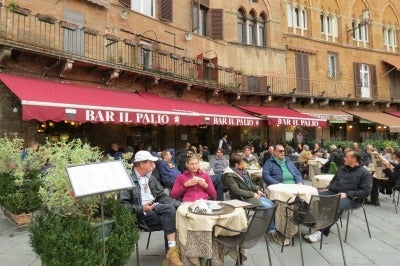 Italians enjoying lunch at the Bar Il Palio in Rome, Italy
Italians enjoying lunch at the Bar Il Palio in Rome, Italy
It’s about lunch
In Italy, lunch is the most important meal of the day. The shops close between 1pm and 3pm and everyone goes home to eat with family and friends. Italians take their time and almost never eat alone.
Breakfast is light
Italian breakfast is most often coffee with a piece of fresh baked pastry like a tart, honey soaked cake, or biscotti.
Hotels may offer a continental breakfast with eggs but that’s mostly for foreigners. Italians love egg dishes, like a tasty frittata, but eat them later in the day. A buffet may also include cold cuts, cereal, yogurt and fruit, which Italians eat in abundance. Americans typically pile up their plates while locals nibble slowly and eat lightly.
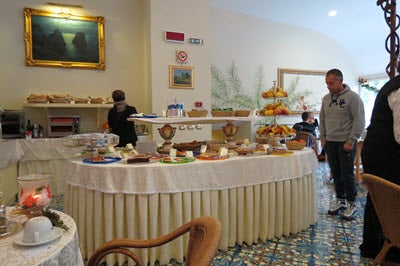
Continental breakfast at the Hotel Antiche Mura in Sorrento, Italy
Dinner is late
Italians go out to dinner at about 9pm. One restaurant we went to in Tuscany wouldn’t let us in until 7:30pm. That debunks the idea of not eating after six.
Don’t utter the words “gluten-free” in Italy
Fresh bread is always served with meals. Each region makes its own style as a complement to their local cuisine. Bread from Naples is salty while Tuscan bread is spongy. Roman bread is a cornucopia of flavors from all over Italy.
When bread is passed in America, we slather it with butter. It’s rare to see a bread plate, let alone butter at an Italian table. The purpose of bread is to mop up pasta sauce or dip in soup. Toppings, like vine-ripened tomato bruschetta, olive tapenades, and fresh ground pâté are hard to pass up.
When I traveled to Italy, I ate all the bread I wanted and never felt bloated. Italians laugh at our gluten-free obsession because their flour hasn’t been altered like ours has.
Pasta is a staple and is eaten daily. Each region boasts its own unique shapes. We ate Pici pasta in Siena and Scialatielli in Sorrento. You can’t beat a plate of homemade Italian pasta!
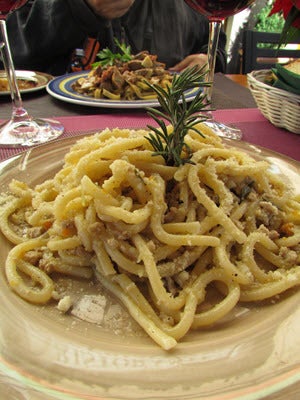
A tasty seafood pasta dish in Florence, Italy
Pasta sauce in Italy is often more flavorful because their tomatoes are nourished by rich volcanic soil. When meat or seafood is added, it’s in small quantities. Softball-sized meatballs sitting on top of a huge plate of spaghetti is Italian American. So is Spaghetti Bolognese, Fettuccini Alfredo, and pepperoni.
Italian pizza is thin crust and light. You can eat an entire round without feeling full. It’s drizzled with tomato sauce and topped with herbs, grilled vegetables, pork, seafood and sometimes a small amount of cheese. You won’t find a monster everything-on-it pizza in Italy.
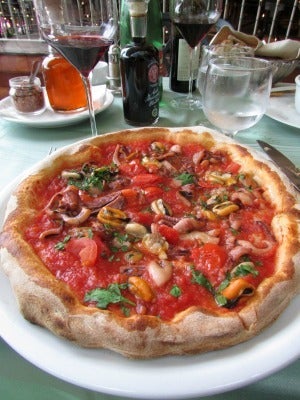
Frutti di mare pizza in Sorrento, Italy (Seafood)
Italians love truffles
Earthy white and dark truffles are found in Tuscany. The months of October and November are when truffle fairs take place in Piedmont, Tuscany, Umbria and Le Marche. We arrived too late for the fairs but went to a truffle tasting in Siena, I ended up bringing home jars of truffle pâté, oil, and sauces.
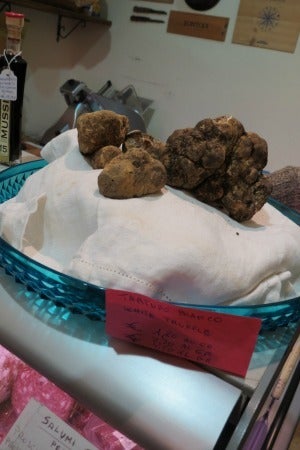
White truffles at a shop in Siena, Italy
Drinking wine is an ancient tradition
Italians love wine with food but consider it bad form to get drunk. Even small children take occasional sips mixed with water. The drinking age is at the parent’s discretion. In the Chianti region, even a cheap bottle of wine is full bodied and rich. Pinot Grigio, Moscato, whites, and rose are also popular.
It’s all about the water
Mineral water is sourced from “termas,” created from volcanos. Small villages have dispensaries where locals can fill up their water jugs. Some of the minerals are known to aid in bone health.
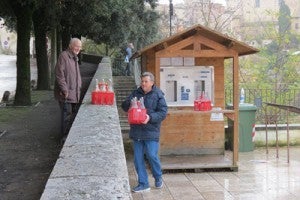
Mineral water dispensary in Montepulciano, Italy
Meat is eaten as an accessory
Pork is popular because it’s the most ancient consumed meat. It’s naturally cured, aged and free from hormones and preservatives. Fresh seafood is plentiful in the coastal regions. Up north in Tuscany, wild boar, rabbit, and other game meats is common fare. However, rather than make meat and fish the main part of a meal, it’s eaten in small portions.
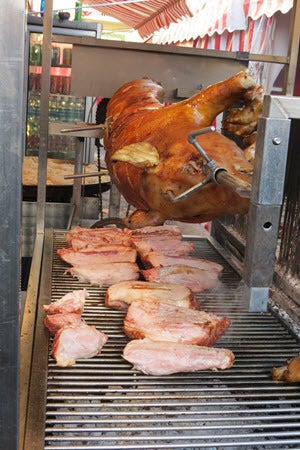
Pig on a spit in Florence, Italy
Italian soup – the secret to Italian longevity
A bowl of homemade vegetable minestrone is rich with nutrition and soothes the soul.
Greens and vegetables
Salads are not a mainstay menu item in Italian restaurants. Radicchio, arugula, and spinach are more often cooked than eaten cold. Bottled “Italian dressing,” as we know it, doesn’t exist. Greens and seasonal vegetables are dressed lightly with extra-virgin olive oil, an aged balsamic, or lemon juice. Olive oil is also an Italian secret to longevity and is generously used in Italian cuisine.
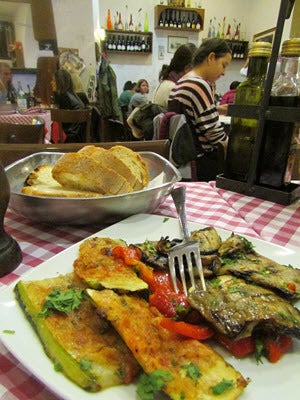
Roasted zucchini and eggplant at a restaurant in Rome, Italy
Sweet indulgences
Italians love sweets like everyone else. They pride themselves in their rich Gelato, Tiramisu, cakes, tarts, and ices.
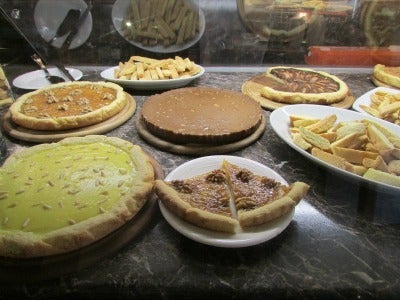
Pies and tarts at a Comune di Montecarlo Lucca
After dinner aperitifs
A meal isn’t complete without a shot of Limoncello or Grappa. Limoncello liqueur, from the Amalfi Coast, is zesty and smooth. Italians call it “the coffee killer” and use it as a digestive. Some say Grappa tastes like paint thinner and isn’t for everyone. I found it to be more like Scotch.
Italians savor meals with family and friends
Overscheduled Americans rush meals and opt for fast-food solutions. Italians are family centric and almost always eat together in large groups, taking their time to socialize and converse. They never worry about calorie consumption because they know they’ll walk it off.
I ate like a glutton when I was in Italy and didn’t gain weight because I walked everywhere. I didn’t worry about what I was putting into my body because it was always fresh from a garden, farm or off a boat.
20 Years OfFreeJournalism
Your Support Fuels Our Mission
Your Support Fuels Our Mission
For two decades, HuffPost has been fearless, unflinching, and relentless in pursuit of the truth. Support our mission to keep us around for the next 20 — we can’t do this without you.
We remain committed to providing you with the unflinching, fact-based journalism everyone deserves.
Thank you again for your support along the way. We’re truly grateful for readers like you! Your initial support helped get us here and bolstered our newsroom, which kept us strong during uncertain times. Now as we continue, we need your help more than ever. We hope you will join us once again.
We remain committed to providing you with the unflinching, fact-based journalism everyone deserves.
Thank you again for your support along the way. We’re truly grateful for readers like you! Your initial support helped get us here and bolstered our newsroom, which kept us strong during uncertain times. Now as we continue, we need your help more than ever. We hope you will join us once again.
Support HuffPost
Already contributed? Log in to hide these messages.
In summary
To eat like an Italian means consuming fresh seasonal vegetables, fruits, whole grains and small amounts of meat in reasonable portions that haven’t been processed or tainted with “flavorings.” Eat slowly and enjoy leisurely meals with family and friends. Then, you can forget about dieting and stay healthy for life.
Rebecca Forstadt Olkowski is the founder of BabyBoomster.com, an online magazine for women over 50 who are passionate about traveling, eating, living well and enjoying life. She also co-hosts the popular podcast 2 Boomer Broads – Life, love, laughs and unsolicited advice for women over 50 available on Itunes and Stitcher Radio. For over 35 years, Rebecca has worked as a professional voice actor in Los Angeles with extensive credits in film, television, cartoons, video games, and is best known for her work in the anime genre.


Dining and Cooking